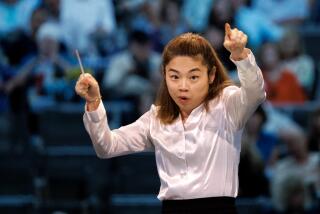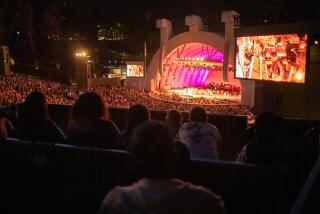The Philharmonic’s rocking, socking night
- Share via
Esa-Pekka Salonen and the Los Angeles Philharmonic are about to hit the road again, to Scotland’s Edinburgh Festival. As a welcome byproduct, they are trying out their three festival programs at the Hollywood Bowl this week, Aug. 5 and 7.
For the home crowd, this ritual has definite benefits. It keeps the orchestra sharp, dispelling the perennial summer doldrums at least for a while. And it provides some good programming at the Bowl for a couple of weeks -- nothing really out there or groundbreaking, but definitely more stimulating than the usual fare.
Yet the prospect of Salonen and his virtuoso orchestra playing three of their flashy showpieces did not seem to be a huge draw Tuesday night. One gazed out at the rows and rows of empty benches -- some whole sections looked vacant -- and the official attendance figure of 6,127 seemed optimistic.
You could blame factors like the bad economy or the worsening traffic hassles (right after the concert, the Hollywood Freeway was completely blocked for half an hour at Lankershim Boulevard because of police action), but it’s been pretty obvious for some time to veteran Bowl observers that “Classical Tuesday” is not as popular as it once was.
In any case, once again we were treated to the bracing pleasure of hearing the Philharmonic rocking and socking its way through Silvestre Revueltas’ “Sensemaya,” which, amazingly, has become standard repertoire around here over the last decade.
Salonen still takes it at a slow, menacing tempo, getting a nicely snarling buzz out of the brasses, building some nasty momentum down the stretch. Most startling of all, thanks to the greatly improved bass response of the Bowl’s amplification system this summer, you could feel the snapping pizzicatos of the double basses.
Debussy’s magical Nocturnes, though, didn’t come off very well in the great outdoors. Salonen took a fast, clear-cut, lean view of “Nuages” and “Sirenes,” transparent in texture yet devoid of drifting sensuality and mist, and crucial quiet passages were masked by traffic noise and intruding aircraft. Alas, the somewhat edgy-sounding sirens of the Pacific Chorale would have had trouble luring unwary sailors onto the rocks. Yet “Fetes” did make an impact with its thrumming, extroverted rhythms and splendidly distant-sounding muted trumpets.
Salonen’s success with the complete Ravel “Daphnis and Chloe” -- not the usual suite that takes in only the last third of the score -- pointed out how different Ravel and Debussy really are, despite having been lumped together as twin apostles of impressionism.
Here Salonen’s energy, precision and classical transparency found their proper vehicle from beginning to end, building rushes of Technicolor climaxes that the sound system could barely contain, firing up the militant sections and relaxing just enough to let the less extroverted passages cast their spell. The wind machine blew lustily away, the Pacific Chorale sang its wordless parts forcefully, and the Philharmonic soloists shone brightly -- particularly Janet Ferguson’s radiant flute work.
Festival-goers in Edinburgh ought to be knocked out by this.
More to Read
The biggest entertainment stories
Get our big stories about Hollywood, film, television, music, arts, culture and more right in your inbox as soon as they publish.
You may occasionally receive promotional content from the Los Angeles Times.










